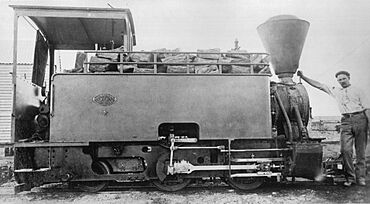Lawlers, Western Australia facts for kids
Quick facts for kids LawlersWestern Australia |
|
|---|---|

O&K locomotive N° 731 of 1902, 610mm, 0-4-2T, 40hp, East Murchison United Ltd, Lawlers, WA
|
|
| Established | 1896 |
| Postcode(s) | 6437 |
| Elevation | 482 m (1,581 ft) |
| Location | |
| LGA(s) | Shire of Leonora |
| State electorate(s) | Kalgoorlie |
| Federal Division(s) | O'Connor |
Lawlers is a ghost town in Western Australia. It's located about 982 kilometres (610 miles) northeast of Perth. A ghost town is a place that used to be a busy town but is now mostly empty. Lawlers is in the Shire of Leonora in a region known for gold.
Contents
History of Lawlers
Lawlers became a town because of gold. Explorers found gold in the area in the early 1890s.
Gold Discovery
Gold was first found near Lawlers by a group of prospectors in 1892. These explorers had travelled from a town called Cue. Patrick Lawler and his group also arrived in 1893. They didn't find much gold at first. But they came back in 1894 and had better luck.
Town Establishment
The town of Lawlers was officially created in 1896. It was named after Patrick Lawler, who found gold there. In 1899, a special machine called a "stamp battery" was built nearby. This machine was used to crush rocks to get the gold out. It was located about 4.5 kilometres (2.8 miles) northwest of the town.
Town Services
A police station and a courthouse were also built in 1899. These buildings helped keep order in the growing town. The police station closed in 1927, opened again in 1938, and then closed for good in 1950. Later, in 1996, a gold mining company used the old building as an office.
Lawlers' Peak
At its busiest time, Lawlers was one of the biggest towns in Western Australia. It had about 8,000 people living there. The town even had its own local government, called the Lawlers Road Board. This board helped manage the town's services. In 1929, the Lawlers Road Board was split up. Its areas were then managed by the Leonora-Mount Malcolm and Mount Margaret Road Boards.
Important People from Lawlers
Several people who lived in Lawlers became well-known later on.
- Dan Mackinnon was a big land owner who raised animals. He was the chairman of the Lawlers Road Board from 1928 to 1929.
- Charles Maley managed a brewery in Lawlers in the early 1900s. A brewery is a place where beer is made. He also served on the Lawlers Road Board. Later, he became a member of the state parliament.
- Emil Nulsen was the secretary for the Lawlers branch of the Australian Workers' Union. This union helps workers with their rights. Emil Nulsen also became a member of the state parliament later on.


